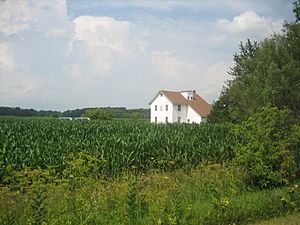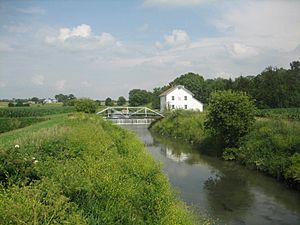Malvern Roller Mill facts for kids
Quick facts for kids |
|
|
Malvern Roller Mill
|
|
 |
|
| Location | Whiteside County, Illinois |
|---|---|
| Nearest city | Malvern; Morrison |
| Area | less than one acre |
| Built | c. 1845-1853 |
| NRHP reference No. | 95000988 |
| Added to NRHP | August 4, 1995 |
The Malvern Roller Mill, also called Appel Mill, is a historic grist mill from the 1800s. A grist mill is a building where grains like wheat and corn are ground into flour or meal. This mill is located near the small village of Malvern, Illinois, in Whiteside County, USA.
The first mill on this spot was built by 1853. However, a big flood destroyed it. The mill you see today was built in 1858. Over the years, many different people owned and ran the mill. The Appel family owned it from 1892 until 1985. The mill closed in 1942. Because of its important history, the Malvern Roller Mill was added to the U.S. National Register of Historic Places in 1995.
Contents
History of the Malvern Mill
The land where the Malvern Roller Mill stands was bought by William P. Hiddleson in 1845. We don't know exactly when he built the first mill on the east side of Rock Creek. But we do know it was working by 1853. Mr. Hiddleson also built a dam across the creek.
Building the Current Mill
A flood on Rock Creek destroyed the first mill. So, the current mill building was constructed in 1858. In 1871, Benjamin Hough bought the mill, and it became known as Hough's Mill. Later, Jacob Geyer bought it in 1875, and his son eventually owned it. During S.L. Geyer's time, it was called Geyer's Mill. Balthaser Schriner bought the mill in 1887.
How the Mill Worked
The first mill used a vertical waterwheel to power it. It also used large buhrstones to grind the grain. These buhrstones are heavy, round stones. You can still find some discarded buhrstones buried nearby.
In the 1870s or 1880s, the mill owners added a 20 horsepower (15 kW) turbine. A turbine is a machine that uses the force of water to create power. This helped the mill keep up with new technology. In 1888, Schriner installed new rollers. Rollers are machines that crush grain between two cylinders, which was a more modern way to grind flour.

The Appel Family Era
In 1892, George Appel, a Millwright (someone who designs or builds mills) from Sterling, Illinois, leased the mill. Mr. Appel had recently moved to the United States from Germany. He and his son used the mill to make oatmeal, corn meal, flour, and bran.
During this time, the mill became known as the Appel Mill, even though its proper names were Malvern Roller Mill or Malvern Milling Company. The Appel family owned the mill from 1892 until 1985. The flour and meal made here were sold in Sterling and even shipped by train to far-off places like New York City and England.
John Appel took over the mill in 1926. He ran it until it closed in 1942. In his last years, he mostly ground grains for local farmers to use as animal feed. He closed the mill because of shortages caused by World War II.
The Malvern Mill Building

The Malvern Roller Mill is a country grist mill located in Whiteside County, Illinois. It sits about 300 feet (91.4 m) from Felton Road, which was moved in 1992. The mill is near the small community of Malvern, about nine miles (14 km) northeast of Morrison, Illinois.
The mill building is on the south bank of Rock Creek, which flows into the Rock River. To the northeast of the mill is a stone dam. This dam stretches 80 to 90 feet (24.4 m to 27.4 m) across Rock Creek and is about 5 feet (1.5 m) thick. It was made stronger with concrete in the 1950s.
The mill building itself, built in 1858, is rectangular. It measures about 26½ feet (8.1 m) by 38 feet (11.6 m). To the west of the mill, there's a Pratt truss truss bridge from around 1890.
Why the Mill is Important
The Malvern Roller Mill was added to the U.S. National Register of Historic Places in 1995. It's important because of its role in local industry and business. The mill helped farmers and the community of Malvern by grinding their grains from when it was built until it closed in 1942.
This mill is special because it's the only known mill in northwestern Illinois that still has all its original equipment for an "all roller" grinding process. This means it used rollers instead of traditional grindstones. If the millrace (the channel that directs water to the mill) and turbines were cleaned, the mill could still work just like it did when it was in business! The Malvern Roller Mill helps us understand how complex milling operations were in the late 1800s.
- Kolzow, David A. and Janet E. "Malvern Roller Mill," (PDF), National Register of Historic Places Nomination Form, 11 November 1994, HAARGIS Database, Illinois Historic Preservation Agency. Retrieved 10 July 2007.

